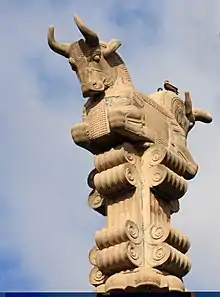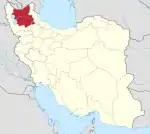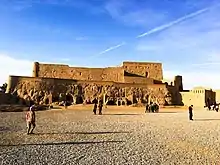Babak Fort
Pāpak Fort (Persian: دژ بابک) or Babak Castle[1] (Persian: قلعه بابک), ″Ghal’eh-e Baz″ is a large citadel on the top of a mountain in the Arasbaran forests, 50 km from Ahar, one parasang from Ardabil, 6 km southwest of Kalibar City in northwestern Iran.[2][3] According to Ibn al- Nadim, it was the stronghold of Javidhan and Babak Khorramdin, the leaders of the Khurramites in Iranian Azerbaijan who fought the Islamic caliphate of Abbassids.[1][4] The fort was conquered and ruined by Afshin′s army on 837.[5][6][7][8]
| Babak Fort | |
|---|---|
دژ بابک | |
| Near Kalibar City in Iran | |
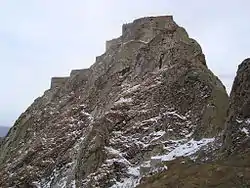 Babak Castle | |
| Type | Citadel |
Access
The castle, built on 2300–2600 meter heights, surrounded by 400 to 600 meter gorges, is accessed via a long series of broken steps that lead to the top of a hill. Thereafter, the easiest route is a long dirt track. No signs lead to the Castle. At the end of the dirt track, the route turns left. The first sign of the ruins appears on the left, leaving two peaks to cross. The first peak has views of the Castle. After ascending a second peak, with additional ruins, the trail passes sheer cliffs on the right with no railings. From the castle, the surrounding Arasbaran oak forest, jagged cliffs, mountains in the distance, and Iranian history combine inform the visitor's perspective. The last stretch is a narrow passageway and a 200-meter corridor-shaped temple. Being located in the mountains with complex passages, as well as, in the winter, heavy rains and snow made it impossible to capture the Bazz fortress.[9][10]
History
The castle is believed to belong to the Parthian dynasty, as modified under the Sasanid dynasty.[11]
Khorramites in the fort
The movement of Khurramites in Azerbaijan was associated with Javidhan who was a landlord leader of one of the two Khurramite movements in Azerbaijan (from 807-808 to 816-817), with his headquarters being in Badd located close to the river Aras. The leader of the other Khurramite movement was Abu Imran, who often clashed with Javidhans forces. During one of the clashes, in probably 816, Abu Imran was defeated and killed, whilst Javidhan was mortally wounded, dying three days later. Javidhan was succeeded by his apprentice Babak Khorramdin, who also married Javidhan's widow.[12][6]
Tabari records that Babak started his revolt in 816–817. At first, Al-Ma'mun paid little attention to Babak′s uprising because of the difficulty of intervening from distant Khorasan, the appointment of his successor, and the actions of al-Fadl ibn Sahl. Such conditions paved the way for Babak and his supporters. Caliph Al-Ma'mun sent general Yahya ibn Mu'adh fought against Babak in 819–820, but could not defeat him several times. Two years later Babak overcame the forces of Isa ibn Muhammad ibn Abi Khalid. In 824–825 the Caliphate generals Ahmad ibn al Junayd and Zorayq b. ′Alī b. Ṣadaqa were sent for subdue Babak's revolt. Babak defeated them and captured Jonayd. In 827–828 Moḥammad b. Ḥomayd was sent to overcome Babak. Despite several victories, in the last battle at Hashtadsar in 829, his troops were defeated by Babak. Caliph Al-Ma′mun's moves against Babak had failed when he died in 833. Babak's victories over Arab generals were associated with his possession of Badd fort and inaccessible mountain stronghold according to the Arab historians who mentioned that his influence also extended to the territories of today’s Azerbaijan Republic- "southward to near Ardabīl and Marand, eastward to the Caspian Sea and the Shamakhi district and Shervan, northward to the Mughan (Moḡān) steppe and the Aras river bank, westward to the districts of Julfa, Nakhchivan, and Marand".[13][14][12][15][16][17]
The last battle between the Arab caliphate and the Khurramites took place in the fortress of Badd on 837. The Khurramites were defeated and Afshin reached the Badd. Afshin had additional forces from the Caliphate under the Arab magnate Abū Dolaf and settled in a camp six miles away from Badd fortress. He used this camp as a base for mountain attacks against Badd. After using up siege machinery and naphtha-throwers, he was able to invade Badd. The Khurramites were defeated and after capturing the Badd fortress, Babak escaped, but was then captured and executed.[18][13][12][15][19]
Present day
The remaining parts of the fortress is currently known as Qaḷʿa-ye Jomhūr. It is situated 50 km from Ahar on the left branch of Qarasū river. A castle and a palace on the top of a mountain have remained from the Badd fort.[9]
The castle was included in the list of national, historical and cultural places in 1966. It was then renovated by the Cultural Heritage Organization of Iran and is used as a hiking place.
There were found coin and pottery samples belong to the 13th century. There were also carved and glazed potteries uncovered date to the beginning of the 7th century.[20][21]
Gallery
.jpg.webp) Babak Fort
Babak Fort.jpg.webp) Babak Fort
Babak Fort Babak Castle
Babak Castle Babak Fort
Babak Fort Babak Fort
Babak Fort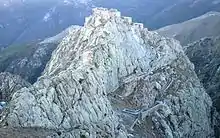 Babak Castle
Babak Castle Babak Fort
Babak Fort
See also
- Iranian architecture
- Arasbaran forests
Notes
- Burke, Andrew and Elliott. Mark (2008) Iran Lonely Planet, Footscray, Victoria, Australia, page 159, ISBN 978-1-74104-293-1
- Scot Aghaie, Kamran; Marashi, Afshin (2014). Rethinking Iranian Nationalism and Modernity. University of Texas Press. ISBN 9780292757493.
- Ubaydallah Ibn Khordadbeh, Abu al-Qasim (1990). Kitab Al-Masalik wa al-Mamalik (كتاب المسالك و الممالك) Book of the Roads and Kingdoms. Dar Sader. ISBN 978-9953135458.
- ibn Isḥāq Ibn al-Nadīm, Muḥammad (1872). Müller, August (ed.). Kitâb al-Fihrist. F. C. W. Vogel.
- "AFŠĪN – Encyclopaedia Iranica". iranicaonline.org. Retrieved 2020-09-11.
- Crone, Patricia (2012). The Nativist Prophets of Early Islamic Iran: Rural Revolt and Local Zoroastrianism. Cambridge University Press. ISBN 9781139510769.
- "BĀBAK ḴORRAMI – Encyclopaedia Iranica". iranicaonline.org. Retrieved 2020-09-11.
- Bahramian, Ali; Hirtenstein, Stephen; Gholami, Rahim (2013-12-04). "Bābak Khurram-Dīn". Encyclopaedia Islamica.
- "BAḎḎ – Encyclopaedia Iranica". iranicaonline.org. Retrieved 2020-09-11.
- "BĀBAK ḴORRAMI – Encyclopaedia Iranica". iranicaonline.org. Retrieved 2020-09-11.
- "Archived copy". Archived from the original on 2011-10-11. Retrieved 2011-10-11.CS1 maint: archived copy as title (link)
- "Bābak Ḵorrami". Encyclopaedia Iranica. Retrieved 2020-09-11.
- Saeed, Nafisi (1963). Bābak-e Ḵorramdīn (second ed.). Tehran.
- "Azerbaijan iv. Islamic History to 1941". Encyclopaedia Iranica. Retrieved 2020-09-11.
- "Ḵorramis". Encyclopaedia Iranica. Retrieved 2020-09-11.
- al-Tabari, Abu Jaafar (1951). The Reign of Al-Muʻtasim (833-842). American Oriental Society.
- K̲h̲ān Najībābādī, Akbar Shāh (2001). History of Islam. 2. Darussalam. ISBN 9789960892887.
- Signes Codoñer, Juan (2016). The Emperor Theophilos and the East, 829–842: Court and Frontier in Byzantium during the Last Phase of Iconoclasm. Routledge. ISBN 9781317034278.
- ibn Abī Ya‘qūb al Yaqubi, Ahmad. Tarikh Yaqubi: Islamic History Book. Urdu-Books.
- @NatGeoUK (2018-10-16). "Iran: Meeting the nomads of Babak Castle". National Geographic. Retrieved 2020-09-11.
- "Difficult but worthwhile ascent". Mehr News Agency. 2019-08-11. Retrieved 2020-09-11.
